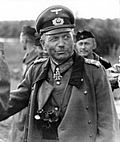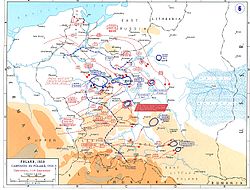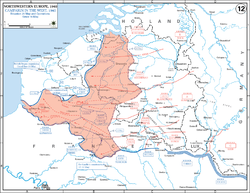Blitzkrieg
| Part of a series on |
| War |
|---|
Blitzkrieg is a German word that means "lightning war" and refers to the high speed of a lightning bolt.
In blitzkrieg, the attacking motorized infantry armies move quickly and are helped by tanks and aircraft. Slower-moving enemy units are overrun or surrounded and often captured with little fighting. The slower units often become disorganized and are not ready to fight when they are captured.
The combined arms tactics of blitzkrieg were developed in the 1920s and 1930s, especially in the German Wehrmacht. They seldom used this word, however.
This method worked well early in World War II during the invasions of Poland and France and was mostly successful during Operation Barbarossa. Later in the war, the Allies learned to defeat German blitzkrieg attacks by defence in depth and by attacking the flanks of the attackers with reserve forces.
The Blitz refers to the German bombing of Britain, particularly London, during World War II. It destroyed over a million homes, killed over 40,000 people and was supposed to destroy industry and morale quickly to make the British pressure their government to end the war. The Blitz started in September 1940, in response to the British bombing of German cities by the Royal Air Force and continued until May 1941.
Blitzkrieg Media
Tanks and mechanised infantry of the 24th Panzer Division advancing through Ukraine, June 1942, typifying fast-moving combined arms forces of classic blitzkrieg
British armoured car and motorcycle at the Battle of Megiddo (1918)
The Ju 87 "Stuka" dive-bomber was used in blitzkrieg operations.
The Hawker Typhoon, especially when armed with eight RP-3 rockets, posed a threat to German armour and motor vehicles during Operation Overlord in 1944.










